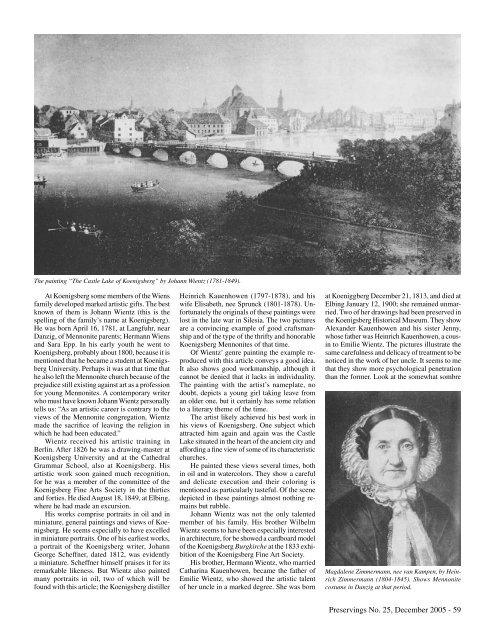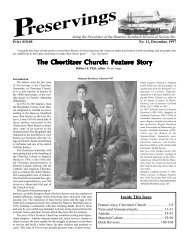Preservings $20 No. 25, December, 2005 - Plett Foundation
Preservings $20 No. 25, December, 2005 - Plett Foundation
Preservings $20 No. 25, December, 2005 - Plett Foundation
Create successful ePaper yourself
Turn your PDF publications into a flip-book with our unique Google optimized e-Paper software.
The painting “The Castle Lake of Koenigsberg” by Johann Wientz (1781-1849).<br />
At Koenigsberg some members of the Wiens<br />
family developed marked artistic gifts. The best<br />
known of them is Johann Wientz (this is the<br />
spelling of the family’s name at Koenigsberg).<br />
He was born April 16, 1781, at Langfuhr, near<br />
Danzig, of Mennonite parents; Hermann Wiens<br />
and Sara Epp. In his early youth he went to<br />
Koenigsberg, probably about 1800, because it is<br />
mentioned that he became a student at Koenigsberg<br />
University. Perhaps it was at that time that<br />
he also left the Mennonite church because of the<br />
prejudice still existing against art as a profession<br />
for young Mennonites. A contemporary writer<br />
who must have known Johann Wientz personally<br />
tells us: “As an artistic career is contrary to the<br />
views of the Mennonite congregation, Wientz<br />
made the sacrifice of leaving the religion in<br />
which he had been educated.”<br />
Wientz received his artistic training in<br />
Berlin. After 1826 he was a drawing-master at<br />
Koenigsberg University and at the Cathedral<br />
Grammar School, also at Koenigsberg. His<br />
artistic work soon gained much recognition,<br />
for he was a member of the committee of the<br />
Koenigsberg Fine Arts Society in the thirties<br />
and forties. He died August 18, 1849, at Elbing,<br />
where he had made an excursion.<br />
His works comprise portraits in oil and in<br />
miniature, general paintings and views of Koenigsberg.<br />
He seems especially to have excelled<br />
in miniature portraits. One of his earliest works,<br />
a portrait of the Koenigsberg writer, Johann<br />
George Scheffner, dated 1812, was evidently<br />
a miniature. Scheffner himself praises it for its<br />
remarkable likeness. But Wientz also painted<br />
many portraits in oil, two of which will be<br />
found with this article; the Koenigsberg distiller<br />
Heinrich Kauenhowen (1797-1878), and his<br />
wife Elisabeth, nee Sprunck (1801-1878). Unfortunately<br />
the originals of these paintings were<br />
lost in the late war in Silesia. The two pictures<br />
are a convincing example of good craftsmanship<br />
and of the type of the thrifty and honorable<br />
Koenigsberg Mennonites of that time.<br />
Of Wientz’ genre painting the example reproduced<br />
with this article conveys a good idea.<br />
It also shows good workmanship, although it<br />
cannot be denied that it lacks in individuality.<br />
The painting with the artist’s nameplate, no<br />
doubt, depicts a young girl taking leave from<br />
an older one, but it certainly has some relation<br />
to a literary theme of the time.<br />
The artist likely achieved his best work in<br />
his views of Koenigsberg. One subject which<br />
attracted him again and again was the Castle<br />
Lake situated in the heart of the ancient city and<br />
affording a fine view of some of its characteristic<br />
churches.<br />
He painted these views several times, both<br />
in oil and in watercolors. They show a careful<br />
and delicate execution and their coloring is<br />
mentioned as particularly tasteful. Of the scene<br />
depicted in these paintings almost nothing remains<br />
but rubble.<br />
Johann Wientz was not the only talented<br />
member of his family. His brother Wilhelm<br />
Wientz seems to have been especially interested<br />
in architecture, for be showed a cardboard model<br />
of the Koenigsberg Burgkirche at the 1833 exhibition<br />
of the Koenigsberg Fine Art Society.<br />
His brother, Hermann Wientz, who married<br />
Catharina Kauenhowen, became the father of<br />
Emilie Wientz, who showed the artistic talent<br />
of her uncle in a marked degree. She was born<br />
at Koeniggberg <strong>December</strong> 21, 1813, and died at<br />
Elbing January 12, 1900; she remained unmarried.<br />
Two of her drawings had been preserved in<br />
the Koenigsberg Historical Museum. They show<br />
Alexander Kauenhowen and his sister Jenny,<br />
whose father was Heinrich Kauenhowen, a cousin<br />
to Emilie Wientz. The pictures illustrate the<br />
same carefulness and delicacy of treatment to be<br />
noticed in the work of her uncle. It seems to me<br />
that they show more psychological penetration<br />
than the former. Look at the somewhat sombre<br />
Magdalene Zimmermann, nee van Kampen, by Heinrich<br />
Zimmermann (1804-1845). Shows Mennonite<br />
costume in Danzig at that period.<br />
<strong>Preservings</strong> <strong>No</strong>. <strong>25</strong>, <strong>December</strong> <strong>2005</strong> - 59

















